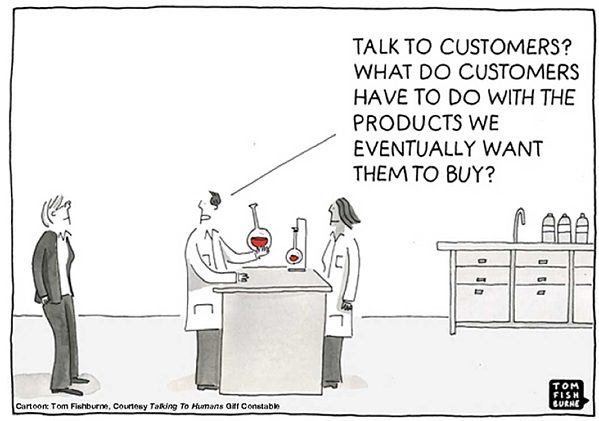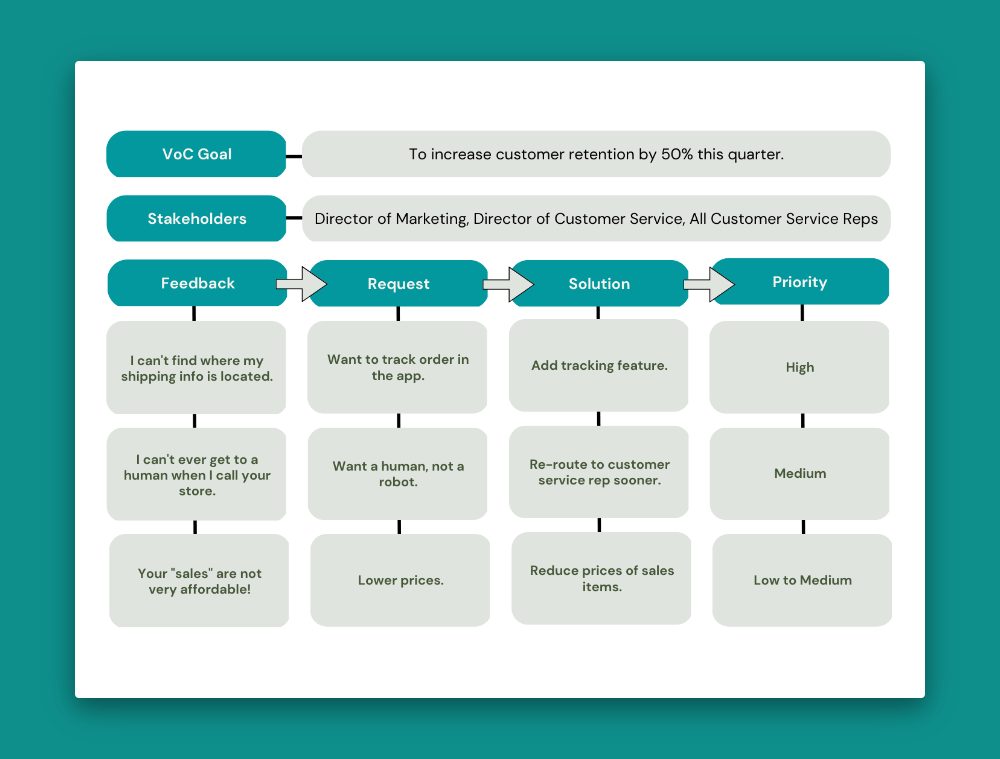How to Create a Voice of Customer Template for Your Business

Last updated on March 8, 2024
It’s important for your business to understand your customers. You need to know how they use your products or services and what they expect from you. Using a customer needs analysis and setting up a feedback loop are the key ways to make this happen.
You probably know this. But where do you start? One of the best analysis techniques available is the voice of customer (VoC) template. It will help you gather valuable feedback, identify customer pain points, and work towards better solutions.
This article will explain what VoC is, how to use it, and tips on creating your own voice of customer template for your business.
Ready to dive in?
In This Article:
What is Voice of Customer(VoC) and Why Is It Important?
A voice of the customer (VoC) is the process of gathering customer feedback to discover what they need, want, and expect from you.
The goal is to better understand your customers, earn their trust, and improve customer experience. The voice of the customer can also help you identify and address any issues preventing you from achieving key goals.
Additionally, the voice of the customer encompasses both positive and negative feedback on a variety of topics. It could cover products, services, prices, and brand perception. In recent years, VoC has gained popularity as new technologies have expanded how companies receive and process customer feedback.
We’ll say it here – It’s impossible to overemphasize how important customer feedback is. Without it, you’ll never know what a customer wants or expects. Business owners have always sought out customer opinions. But in our digital age, receiving feedback has never been easier. Thanks to the Internet, customer feedback has never been so accessible.
Learning what your customers think about your products or services isn’t difficult. Customer experience templates, customer survey templates, or customer satisfaction survey templates allow you to make informed decisions on improving the customer journey.
Without customers, there is no business. That’s why the voice of the customer is an essential part of any successful business strategy.
By understanding what your customers want and need you can ensure that you are providing them with the best possible service or product which will help you stay ahead in an ever-changing market.
When to Use Voice of Customer
Before we cover building your own VoC template, let’s talk about when to use this type of analysis. Remember, you should always care about what your customers say. Using the voice of the customer isn’t something you only use once and never turn to it again. It should be a regular part of your customer experience strategy.
Instead, you should see VoC as a tool to gain unique insights. Let’s look at several reasons you should consider using VoC.
- Verifying customer feedback. Use VoC to verify customer feedback, enabling businesses to make more informed decisions based on actual customer experiences. In addition, VoC can provide insights into customer preferences, allowing companies to tailor their communication, featured items, or other offerings.
- Quantifying customer feedback. It might feel impossible to put a number by feedback. How do you “rate” an emotional response complaining about a problem with your website? The good news is that you can assign a rating or score based on the relevance and importance of each insight. These insights can help you make better decisions. They will also help you train your customer service reps in de-escalation.
- Launching new initiatives. Insights from data analytics can help create new product designs or services. Data can also inform pricing strategies for a better return on investment.
- Keeping up with industry standards or new trends. You need to remain competitive in the market and make a profit. But you also need to maintain relationships with your customers. Continue to create meaningful connections with customers while still keeping your business profitable.
- Improving brand perception. This can include analyzing customer reviews and surveys, understanding what customers are saying about the brand online, and taking steps to address any issues that may be affecting your reputation. By doing this, businesses can ensure that their brand is well-regarded by customers and potential customers alike.
- Increasing customer loyalty. Feedback will reveal what customers want and how you can improve your products or services. This information helps create targeted campaigns that will help increase customer retention rates and build long-term relationships with customers.
How to Create a Voice of Customer Template
A voice-of-customer template helps you collect and interpret customer feedback. The template is a framework for setting goals, involving the right people, identifying solutions, and tracking progress throughout the process.
While a VoC template may be different depending on the company profile and industry, each template should have the following elements.
Setting Your Goal
By gathering customer feedback, you’ll gain a better understanding of where your customers are coming from and what they want. Use this data to identify opportunities for improvement and insights so you can better meet their needs. In the end, you want to see increasing customer satisfaction and loyalty.
Everyone involved in the VoC process must understand how important it is for the success of the business.
Identifying Key Stakeholders
When it comes to collecting, analyzing, and acting on customer feedback, involve every key stakeholder. This includes departments such as customer service, marketing, product development, sales, and even executive leadership.
Each department will bring its own unique perspective to the table. You want as many valuable insights as possible to inform decisions that will improve the customer experience.
Gathering Direct Feedback
Obtaining feedback from customers is essential. But how do you get well-rounded data? Only if you get direct feedback using every possible medium. With an omnichannel approach, you’ll gather feedback from the following:
- Online surveys
- In-App surveys/rating request
- Chatbots
- Customer interviews
- Your Net Promoter Score
- Online product reviews
- Social Media mentions and DMs
You’ll gain deeper insights into a customer’s behavior and preferences by collecting their direct feedback. Being proactive here will help you get ahead of the curve by measuring customer satisfaction.
As you work through the template, you’ll see that this collected feedback will be used to identify areas for improvement in service delivery, product design, and more.

Finding the Primary Request
Every piece of customer feedback, no matter how lengthy or detailed, can boil down to a primary request. To do this well, customer feedback must be carefully analyzed and interpreted to identify the underlying issue that needs a customer has.
This might mean some translation work on your part. Not every customer will state explicitly what their main problem is. It’s important to read between the lines to find any hidden issues.
Providing Solutions
In certain cases, large feature updates may be needed to successfully resolve an issue while in other scenarios, smaller bug fixes and modifications as well as ensuring that customers have the right information about a product or service. The choice of which fix to use depends on the complexity of the problem, availability of resources, and time constraints.
When trying to enact changes in your organization, it is important to rank them based on your resources and the time available. This is where prioritization comes into play.
Prioritizing the Needs
After completing the preceding steps, rank each solution based on its potential value and return on investment. Due to limited resources and bandwidth, you should focus on those initiatives that will have the greatest impact. Which need would benefit the largest number of customers in the shortest amount of time?
You’ll want to consider the main project goal as you do this. If not, you’ll spend time, energy, and money on priorities that won’t help reach your desired outcomes or increase the bottom line.
Here’s a visual representation of what a template could look like:

Using this template will help you act quickly and efficiently when customers provide feedback. It is valuable for short-term and long-term feedback strategies. And it will help your company stay agile amidst changing customer needs.
Voice of Customer Best Practices
Now that you have a framework for creating your own VoC template, here are five best practices to help keep in mind.
1. Personalize the Questions You Ask
Customers expect to receive personalized attention. Companies that wish to cultivate loyalty and strong communication should focus on providing more personalized interactions with their customers. This can help them to build a better relationship with their customers.
Your goal is to build stronger relationships and customer loyalty. How you phrase questions can help you do this. Craft questions that put the customer at the center of attention. The way to do that is to help them feel like an individual. Not a number or someone lost in the crowd. This helps the customer feel valued in communication and it creates a more positive customer experience.
2. Gather Feedback at the Right Time
Best practices for obtaining customer feedback involve not only determining which platform they feel most comfortable providing their opinion on, but also the timing of the request. It is usually best to ask them immediately after their experience so that you will receive more accurate responses.
Even as you gather feedback, you want to enhance the customer experience. So try to time interactions with customers according to their individual journeys. Great moments to engage are when a customer’s behavior changes or when an already-purchased product is upgraded or bought again.
3. Share Feedback with Your Whole Company
The success of any business depends on all employees functioning efficiently and effectively together. Though some team members may not have direct interaction with customers, their roles still contribute to the ultimate goal of customer satisfaction. A comprehensive business plan template serves as a guiding framework to align these collective efforts toward achieving organizational objectives. All departments must work as one for a company to thrive.
So that customer feedback is maximized, it should be made available to every employee in the company. The customer success team can create a detailed profile of customers which includes their demographic information, buying preferences, past purchases, as well as other relevant data which can then be shared with every department.
This will enable each department to have better insights into the needs and wants of their target customers. Most importantly, it will help the business as a whole make informed decisions about product offerings.
4. Continue to Listen to VoC
Fostering strong customer relationships often depends on recording their order history and online clicks. In an omnichannel Voice of the Customer (VoC) approach, customers can be asked to periodically answer questions about their lifestyles, routines, and preferences. This helps to deepen the understanding of their needs.
A continued conversation about the customer and their lifestyle, rather than just their immediate needs, can yield deeply useful data to help shape future engagement.
5. Always Respond to VoC
You want all customers to feel appreciated and valued. So it is critical to act quickly and meaningfully upon any feedback received–whether they’ve purchased a product or yelled at a customer service rep on the phone.
Preparing for potential risks in advance is critical to any business’s success. It will help reduce the damage and allow for timely and efficient decision-making.

How to Analyze Your Voice of Customer Data and Generate Actionable Insights
You built your template, followed best practices, and gathered feedback. Exciting! Now, what do you do with the data?
Analyzing VoC data is just as critical as getting the data. It will help you develop strategies to improve customer pain points and satisfaction levels.
Here are three things to help analyze your VoC data.
1. Prepare and Structure Data
Unstructured data sources are pervasive in business and need to be effectively managed. You’ll likely pull data from many sources: text, audio, email surveys, in-person feedback, etc.
Audio recordings are a prime example of unstructured data. An audio file is would need to be manually transcribed for usability purposes. Speech analytics tools allow you to transform a voicemail into a transcription that is organized and searchable. Once you do that, you’ll have an accessible transcript of the message that allows you to convert your data into usable files.
2. Import Data into a Reporting Tool
So you’ve received all the data. And it could be a lot. You’ll need a tool to help you
The reports you end up generating should focus on answering these initial questions. For example, if you are the Director of Customer Experience at a call center, you will likely want to structure a report that highlights caller sentiment, call outcomes, time to resolution, and other customer-centric data points.
Thankfully, we’ve got you covered. You can import your data from a third-party tool. Or you can create your own survey directly with Lumoa and then get started analyzing. Get a free demo of our text analytics or survey analytics tools.
3. Gather Analytics Insights
Analyzing customer feedback is the most important part of the process. You can have data for days, but what’s the point if you don’t learn from it and make the data actionable?
Look for trends in your customers’ emotional and sentiment responses, positive or negative. These will give insight into why they bought something and if they’re likely to be a repeat customer. Don’t forget to focus on the big picture, too. How does the brand appeal to your customers? Do they recommend you to others? Do they leave feeling positive about your brand?
As you take action on these insights, you will make better decisions for your customers and the long-term health of your company.
Wrapping It Up
Creating a great voice of customer template is key to understanding customer feedback and making data-driven decisions. By following the tips outlined in this article, you can create a VoC template that will help your business capture the right information from customers and use it to make more informed decisions.
Your VoC template will lead to valuable insights into customer sentiment and preferences, allowing them to better serve their customers and improve their experience.
Lumoa’s call and voice analytics solution helps you automate the process of listening to your customers share what’s important to them. It automatically detects topics, sentiments, and insights so you can analyze calls at scale. Start your free trial today.



